The Tindall Family Cemetery is a small burial ground located in the extreme southwestern portion of Shenango Township, Lawrence County, Pennsylvania. This cemetery, located close to West Pittsburg and long since abandoned, is steeped in local history as well as popular folklore.
The original white settler of the land on which it is situated was William Tindall, a New Jersey native who fought in the Revolutionary War of 1775-1783. He reportedly took part in the American victory at the Battle of Monmouth on June 28, 1778, when forces under General George Washington defeated British troops as they withdrew north from Philadelphia.
After the war Tindall relocated with his wife and four children to southwest Pennsylvania, possibly in Allegheny County. Tindall left his family in 1796 to settle a 400-acre tract of “Donation Land” in what soon became Shenango Township, Beaver County (later part of Lawrence County). Tindall did not own the land, but was settling and clearing it for its owner in exchange for future ownership of a portion of it.
The Donation Land program was used as an inducement for military service during the Revolutionary War. The Pennsylvania government granted large tracts of “uninhabited” land in the western part of the state to veterans who stayed in service throughout the war. A tract could consist of anywhere from 200 to 500 acres based upon rank and they were distributed by a lottery system. To retain ownership the veterans were required to reside on the lands for five years and clear two acres per every 100 acres granted. Very few veterans awarded these tracts actually settled them, most sold them off to land speculators at cheap prices.
The area where Tindall settled was a small part of what became known informally as the “Chew Tract.” The original Donation Land grant was either to Hugh Breckinridge or Alex Addison, and it came under the ownership of Philadelphia-based lawyers Benjamin Chew Sr. (1722-1810) and his son Benjamin Jr. (1758-1844). The Chews, who speculated in land acquisition, snapped up thousands of acres in Pennsylvania and New Jersey (usually under fictitious names) and later sold them off at huge profits. By my calculations the Chews came to own or co-own the whole southern portion of Shenango Township (which included modern day Slippery Rock Township) – twenty-three large tracts totaling 9,200 acres. Altogether the Chews probably owned as much as 30,000 acres throughout the region. They allowed men like Tindall to settle and eventually claim about half of each individual tract, while they later sold off the remainder of the tract at huge profit. Benjamin Chew Jr., known for establishing the nearby village of Chewton in about 1830, died in 1844 and his heirs sold off most of the remaining lands in western Pennsylvania.
Joining Tindall to help out was a teenager named John Connor, who eventually settled on an adjoining tract to the east. Among their “neighbors” was Irish-born William Cairns, possibly the original white settler of Shenango Township who arrived shortly before Tindall. It was probably in late 1799 that Tindall signed an official agreement with the Chews, where if Tindall stayed for five years he would be entitled to about half the tract. Many other settlers in the region signed agreements with the Chews at about the same time including William Cairns, John Connor, John Frew, Nathaniel Hazen, Abel Hennon, Jacob Book, William Cunningham, Robert Davidson, Andrew Wilson, Charles Morrow, and George Allen.
William Tindall and his wife, the former Elizabeth Jordan, had a total of six children, which they raised on the family homestead along what became Sandbank Road.
Tindall was eventually able to purchase a large part of the land he settled. He established an orchard and managed a large farm on his property. He passed away at the age of ninety-one on June 6, 1838. His family buried him on the property where he had made his longtime home. Other family members, including his wife who passed away in November 1852, and eventually close neighbors were subsequently buried next to him. William Tindall’s son Zachariah (or Zechariah) continued to live on the family farm until he died in November 1879. He was buried with his parents and his first wife (Sarah Jones Tindall) at what became known as the Tindall Cemetery – occasionally referred to as the Turkey Hill Cemetery. Additional members of the Tindall family were buried at other locations to include Newport Cemetery and Savannah Cemetery.
After Zachariah Tindall’s death in 1879 I do not believe his descendants lived on the old homestead for too long. The original Tindall farm and surrounding properties – some owned by other Tindall family members – were mostly acquired by the Crescent Portland Cement Company (purchased by Medusa Cement in 1929), which operated the cement plant in nearby Wampum. The southern portion of Shenango Township was rich in mineral deposits, including limestone needed in the cement-making process. By the 1920’s Crescent Cement had extensive mining operations in the area from Chewton to West Pittsburg.
Periodic burials continued at the small cemetery into the early 1900’s. Among the surnames you would find of those interred there are Aiken, Baldwin, Bessell, Black, Book, Connor, Newswonder, Palmer, Shuler, and Tindall. The latest burial I can find was that of eighty-three-year-old Rebecca Connor, a widow who died on October 28, 1915. Estimates vary but it is believed that between 35-50 people were eventually interred at the location. Included among there are veterans of the Revolutionary War, the War of 1812, and the Civil War.
The rural cemetery was neglected as indicated in this article appearing in the New Castle News of Monday, October 5, 1931: “Boys of the West Pittsburg troop 1, as a good turn measure, have launched their program for improving the old Tindall cemetery, located outside of West Pittsburg. For some time the grounds have become deserted, but the town troop plans to give it constant attention.” I’m sure how long this initiative went on, but the cemetery was basically neglected over the ensuing decades.
The cemetery came back into prominence beginning in 1962 when the extensive limestone mining operations began to threaten the cemetery. Local residents and a few relatives of those buried there petitioned Medusa and the Shenango Township supervisors to start doing more to maintain the cemetery. In October 1962 members of Boy Scout Troop 46 from Shenango Township began a voluntary effort to clean up the cemetery by cutting weeds and brush, picking up scattered debris, and replacing several toppled over tombstones. A ceremony, which included members of the Daughters of the American Revolution (DAR) and the Veterans of Foreign Wars (VFW), to honor the military veterans was held at the cemetery on Tuesday, October 30, 1962.
Unfortunately, the publicity resulting from these events led to numerous curiosity seekers visiting the long-forgotten site in the coming years. Teenagers began hanging out at the site at night and desecrating the cemetery. Stones were knocked over, thrown into nearby swamps, or cracked beyond repair. Beer cans and bottles were discarded throughout the area. Worse yet several of the graves were dug up and the remains apparently scattered.
What really brought thrill seekers to the site was the legend of Mary Black, a local woman buried at the cemetery who was purported to be a witch of some sort. Mary, born as Mary Johnston in Ireland in 1801, married Andrew Black in c1831 and they came to the United States about a year later. They settled in what became Shenango Township and had nine children together. Andrew passed away in 1861 and was buried in the Tindall Cemetery. A widowed Mary lived on for many years until she died at the age of eighty-seven on March 20, 1888. She was also buried at the cemetery.
In the early 1960’s a local man and engaging storyteller named Harry Stein (1903-1980), known more popularly as Harry the Hermit, began spinning entertaining yarns about how Mary Black was a witch and haunted the cemetery. Young people flocked to hear Stein’s stories, but also to visit the cemetery where they caused considerable damage over the years. Police and township officials fought a losing battle to keep people away.
The Boy Scouts of Shenango Township made cleaning up the cemetery an annual project, at least up until the mid-1970’s. By that time several families had undertaken efforts to remove their loved ones’ remains (and there gravestones) from the cemetery. Among those remains removed were those of the cemetery’s namesake William Tindall, who was spared further indignity and reinterred at Savannah Cemetery. His wife’s stone was previously missing and sadly I’m not sure if anyone knows what became of her remains.
Since the 1970’s the cemetery has been outright abandoned and completely open for idiotic vandals. The fate of Mary Black’s gravesite is pretty much what became of the whole cemetery. Because stories reported that Mary Black was buried with expensive jewelry her grave was dug up and her remains were scattered. Her gravestone was also stolen. It was later found discarded in a nearby swamp in the 1990’s and given to the Lawrence County Historical Society for safekeeping.
Medusa was merged into Southdown Inc. in June 1998, which was then purchased by the Mexican cement manufacturer CEMEX in November 2000. That acquisition made CEMEX the largest cement manufacturer in North America. Limestone mining operations continued in earnest to the north of Chewton and as of 2005 the company owned 6,400 acres of property in the area. A large mining operation continues to encroach upon the cemetery and it’s conceivable that it could be buried in runoff stone and debris one day.
Today, not much remains of the secluded cemetery, which sits in a wetlands area and is not easily accessible. The site is located in a valley flanked by a two huge hills being mined for limestone. It essentially sits on “an island” or small plateau surrounded by two small streams, a classic looking swamp, and a large water-filled quarry or large pond. I believe portions of it may be underwater now. Only remnants of a few stones are visible strewn about the thick, thorny underbrush or in the surrounding shallow waters. Several deep depressions indicate where graves have been dug up over the years. Beer cans and cigarette butts can be found bunched in several areas. It truly is a sad sight to behold.
To read an obituary for Rebecca Connor, who was interred in the cemetery in 1915, click on: REBECCA CONNOR OBITUARY.
 A wooden bird house is spotted as you make your way through the rough area. (Mar 2013) |  Getting to the secluded cemetery site requires wading across a few small streams. (Mar 2013) |
 It’s a short walk but rough country is encountered. (Mar 2013) |  Marshlands dominate the area. (Mar 2013) |
 The cemetery is located on the other end of this swamp. (Mar 2013) |  The Aiken stone (or base) can be seen as you approach the plateau upon which sits the cemetery. (Mar 2013) |
 The base of the Aiken stone. The tall pillar portion is long since missing. I believe several members of the Aiken family were buried around this stone beginning in the 1860’s. You can see where shameless vandals have dug up a grave. (Mar 2013) Full Size |
 |
 The base of the Aiken stone. Sadly this is one of the most prominent features left in the abandoned burial ground. (Mar 2013) |  (Mar 2013) |
 A stone can be seen laying in the water. (May 2013) Full Size |
 Another view of the Baldwin stone. I’m doubting this stone was tossed into the water. It’s more likely that the water has just encroached upon the cemetery over the years. I’m guessing there are a handful of other stones submerged beneath the swamps. (Mar 2013) Full Size |
 Another base with its stone missing. (Mar 2013) |  Another base. (Mar 2013) |
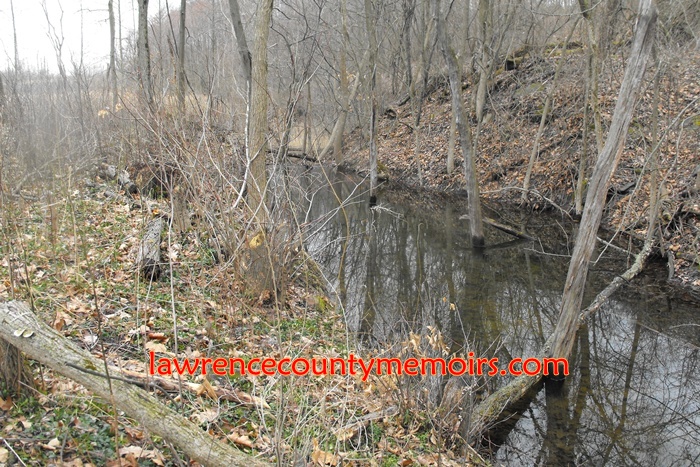 The small stream that borders the northern portion of the cemetery. (Mar 2013) Full Size |
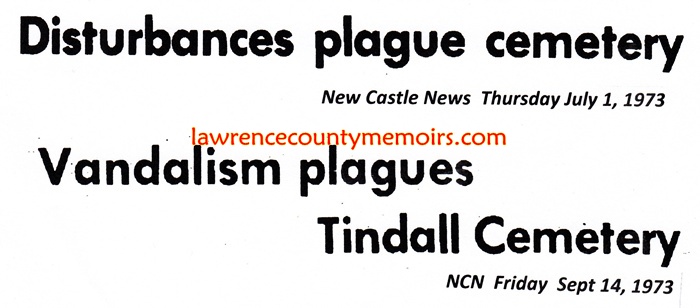 |
 A base that appears to have had it’s thin upright stone broken off. (Mar 2013) |  Another view of the previous base/stone. (Mar 2013) |
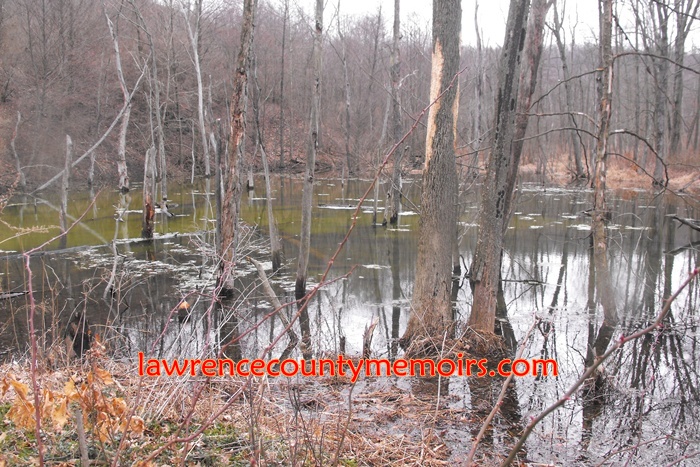 Looking east from the cemetery. Could more stones be hidden in this swamp? (Mar 2013) Full Size |
 A base with its built in stone broken off long ago. (Mar 2013) |  One more base – and once again no stone in sight. (Mar 2013) |
 That’s me (Jeff) beside the Aiken stone during a wintertime visit to the cemetery. (Dec 2016) Full Size |




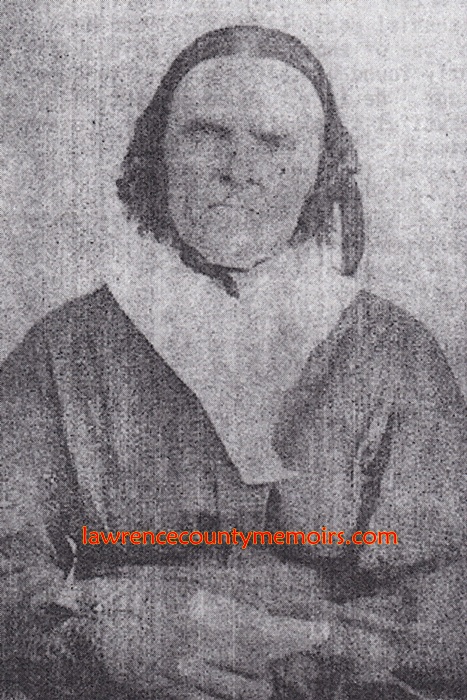

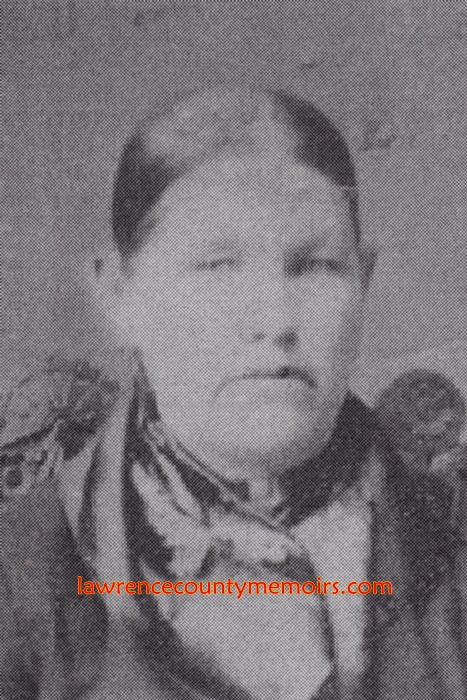


Comments
Karen #
The Baldwin stone was in fact either pushed or rolled by vandals Down into the water the stone used to sit ontop the hill With the other stones (I saw it myself). My Grandmother was a Tindall and I have been to the cemetery many times in the past 40 yrs its a shame what it looks like, the disrespect people have of the dead is unbelievable.
Thomas Welsh #
Thank you for taking the time to write about this long forgotten history.
I grew up in New Castle, PA. I’ve met Mr. Stein when I was a teenager. I did not like the way many of the young “punks” treated him.
I still recall Harry talking about bathing during the winter months…Who knew he was ahead of his time (My doctor tells me cold showers are healthy for me)…He,Harry the Hermit, was a great story teller. I was just too immature to understand it at the time…
Thanks again….
Thomas
Lauri #
I took a trek back today and did not get any further than the swamp. I was not sure if it was safe to cross through, so we turned back and left. I was disappointed, to say the least. I am a cemetery photographer and I would have loved to captured a few shots of some headstones. And of course pay my respects. It’s really sad to know how this cemetery has been mistreated.
Barbara Cooper #
I worked at Hill View Manor for 12 years-starting in 1979. Harry Stein was a resident of Hill View at the time…he was a nice man. Most of us at Hill View didn’t realize he was a “local legend” until after he passed away.
John #
Great but very sad article. I would like to visit this cemetery and pay my respects but I’m not sure of it’s exact location or if it is considered trespassing. Do you know if there is anyway I could get involved to somehow try and restore or at least preserve this cemetery?
Daniel Appel #
Hello,
I am William Tindall’s great great great great great grandson. Many of my family members are buried here. Is there any way I could get involved with the restoration process? I am in the Philadelphia area.
Thank you!
Barbara Cody #
My grandson is a 7th generation descendant of William Tindall. When my father in law (Covert Tindell Sr.) was in the service the family name was spelled incorrectly (Tindell) instead of Tindall . Covert never bothered to have it corrected and so there are four generations of Tindells in the Beaver County Pa area I once was told that the Tindall name was originally Tyndale (English ) and that Covert’s sister had some type of article with the family crest. Covert clearly remembers in the early 60’s when they moved Williams stone to Savannah Cemetery in Shenango twp.
Joneta Burke #
Such a sad story. I hope the above family members are able to do something to fix this mess.
Jeff Bishop #
I believe that the New Castle Historical Society has (or had) the headstone for Mary Black. There was a story about it in the New Castle News back in the 1980’s. I used to wander back and visit the cemetery when I was a kid. It was in bad shape then, but not nearly as bad as it is now.
Mike James #
I remember hearing stories that Mary Blacks remains were dug up and left at Vo-Techs parking lot along with her tombstone and they reburied her in a secret location. Does any one know the story?
Brandi #
New castle historial center has mary black’s head stone I seen it myself while doing research. It is very sad that people could do this and it is very disrespectful. My mother used to tell me the stories about mary black when I was a kid she told me her experiances with visiting turkey hill when she was young.
Josh Lenhart #
My grandpa and his family had a farm on turkey hill. He used to live near harry and always tells me about the stories he used to tell but has not mentioned much experiences about Mary Black. I have been fishing at a swamp near the area but have never seen the cemetery.
Jaison #
I was just on the site of the cemetery last night with a friend and his boys. This is the second visit I made to the cemetery. The first was a couple years back when corresponding through email with the author of this site. I see just in the few posts here that people are interested in working on preservation of the cemetery. I can say my friend and I have had interest in helping. He lived in the area for a few years and his kids still do. We both were fascinated with the history of the cemetery. To us, it was a big deal that there are war veterans buried there. Three things concern us. First, the vandalism that has been done over the years is somewhat irreversible. Next, the amount of water standing in the area will be a great obstacle. It actually should be something that is corrected. Respect for the remains in the cemetery is good enough reason. And again, some are war veterans. Third, I wonder, does a project to do some preservation or repair only again attract vandals?
Richard J. Harvey #
Josh Lenhart I probably know your father, since I grew up on Turkey Hill and knew the Lenhart’s who lived there also. I first came across Tindal Cemetery in 1947 shortly after having moved onto Turkey Hill. In those days although it was overgrown the graves and tombstones were untouched by the vandals who came much later. In the 1960’s a group of boyscouts cleaned out the underbrush and shortly after that a sportmans club built a lake nearby and then the vandals moved in. I spent many hours exploring and hunting in the area as a teenager. It sickens me to see what has been done to the cemetery.
Paulette VanAntwerp #
Thank you for this informative article, although very sad, indeed. Elizabeth Jordon is a distant relative, and any information I find is greatly appreciated.
John #
Has anyone been here in the past year? Any updates or pictures? Has anything been done?
Tom Brown #
William Tindall is my 4th great grandfather through Edith, only child of his first wife, Edith (presumably Ambler). William’s daughter married Abraham Brown in Hightstown, NJ in 1797, and I am somewhat surprised not to see his name included here since my 3rd great grandfather was born in old Beaver County in 1798 and his children married into several of the families mentioned here, i.e. Connor & Book. Abraham can be found on census forms as a neighbor to others such as the Baldwins and Palmers until his death in Shenango in 1851. We do not know where Abraham and Edith are buried but since Edith died around the same time as her father, it makes some sense that they shared a burial ground together and that Abraham followed them to it. A number of these Lawrence County families had members who began moving to Van Wert County in western Ohio in the 1840s along with some of the Tindalls and Browns. If any of this sounds familiar, please contact me.
Charles shutack #
A very interesting article, my family has lives on sandbank road , as far as I can research I’d say for the last 250 years. I’m guessing the name black was changed to blake around 120 years ago to sound less irish my step grandfather who was actually my great uncle was my grandmother’s brother and they all grew up in a house that was bout a quarter mile from the cemetery, the family bible wich I need to actually to finish my family tree is Mia ,,I haven’t seen it since I was a kid. It’s a shame how run down the cemetery is. I’ve spent alot of time up there at the lake and the cemetery. If I can help any kind of clean up please contact me ,
7247186717, (chuck)
JAMES MEDVED #
William Shuler is my great, great grandfather or more greats. I heard he was moved to Savannah cemetery. Have not located his grave or stone. we did swim and fish at the old sportman’s lake when I was young. early 60’s, remember seeing the graves, and a lot of them were already damaged. never found his grave then either. was curious if a recorded was kept on grave relocation.
Justin Hill #
I am a great grandson not sure what removed of William Tindall. I am trying to get in contact with anyone related to him as well. I have seen a few of you on this message board. Email me at jlhill9110@yahoo.com
Dwight E. Davidson #
Jeff Good Afternoon
I am one of several 8th generation great grandson of the late Robert Davidson resting peacefully in your Tindall Family Cemetery. Our broader family possess several artifacts from the Davidson Family (i.e. Wampum) as they grew up in and around the greater Pittsburgh area during the 1800’s, through and into the 1900’s and now well into the 21st Century.
I write you today to ask for your permission to meet you sometime in the future (no rush) and take a respectful walk in-and-around-and-through the cemetery. I and my brothers look forward to your response.
Respectfully
Dwight E. Davidson
Greenville, SC
Robert B. Davidson
Charlotte, NC
Scott W. Davidson
Orlando, FL
Tracy Cates #
Hello, William Tindall was my 7th Great Grandfather. I am interested in learning if the Shuler family buried at Turkey Hill (Tindall Cemetary) is related to the Tindall family or are they neighbors or friends who happen to have been payed to rest there. I am attempting to track my Native American roots. I am also interested in finding any distant relatives and connecting the dots of my heritage. Any help would be useful. Sincerely, Tracy Sera-Cates
Carol Dachko Ciaccia #
I lived on Aiken Road in Shenango and Baldwin road is located across from Aiken Road. Now I know why and who the roads were named.
Richard Tindell #
My grandfather and all of his brothers grew up in Willow Grove. My dads brother Ernest was one of the first to be hired on the Pennsylvania RR at Mahoning yard. My dads aunt Mimmie Wiggley had a small store. Used to go there all of the time as kids. Still remember the penny candy and coke ice chest. My cousin Larry still lives by the old bridge.My aunt Carol Romesburg raised her family there Somewhere down the lien I guess all of us. Are related in some way Μzny g g g g Gil g g g grandchildren
Richard Tindell #
In addition to the above post, my grandfathers name was Covert Steven Tindell, my dad was Covert Earnest Tindell, and my middle name is Covert, hence Covert rd
Michael Roth #
I am a direct ancestor to this Tindall Family. I would like to bring my mother around that area sometime. We live in Ohio and will gladly make arrangements if I need to.
Thank you, I look forward to your response
Comment